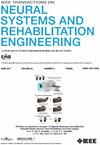研究训练方案对上肢截肢者肌电模式识别控制的影响。
IF 4.8
2区 医学
Q2 ENGINEERING, BIOMEDICAL
IEEE Transactions on Neural Systems and Rehabilitation Engineering
Pub Date : 2025-03-26
DOI:10.1109/TNSRE.2025.3555100
引用次数: 0
摘要
肌电控制方案是假肢控制的关键,通常在理想的实验室条件下开发和评估。然而,这些受控环境可能无法完全代表用户在真实场景中面临的各种挑战。本研究旨在通过探索各种模型训练协议对半自主控制系统中肌电模式识别的影响,解决现有研究的一些局限性,这已被证明可以减少用户认知负荷并提高整体系统性能。具体来说,我们关注肢体运动和负重活动的影响。我们研究了四种不同的训练方案对上肢假肢模式识别控制的影响,包括无假手训练、有假手和静态手势训练、有假手和图形用户界面(GUI)指导的动态运动训练,以及有动态转移和无指导的假手训练。通过检查这些条件,我们的目的是提供不同的训练方案和不同的标记方法如何影响肌电模式识别控制的理解。通过对14名健全人和1名截肢者的实验,我们的结果表明,在训练数据中引入假手的重量和手臂的动态运动可以提高控制方案的准确性和鲁棒性。使用多自由度假手对5名健全人和1名截肢者进行实时控制实验也验证了我们的发现。本文章由计算机程序翻译,如有差异,请以英文原文为准。
Investigating the Impact of Training Protocols on Myoelectric Pattern Recognition Control in Upper-Limb Amputees
Myoelectric control schemes, pivotal in the control of prosthetic limbs, are often developed and evaluated in ideal laboratory conditions. However, these controlled environments may not fully represent the diverse challenges users face in real-world scenarios. The present study aims to tackle some of the existing research limitations by exploring the influence of various model training protocols on myoelectric pattern recognition within a semi-autonomous control system, which has been shown to reduce user cognitive load and enhance overall system performance. Specifically, we focus on the effects of limb movement and weight-bearing activities. We investigate the effect of four distinct training protocols in pattern recognition control for upper-limb prostheses, including training without a prosthetic hand, training with a prosthetic hand and static gestures, training with a prosthetic hand and dynamic movements guided by a graphical user interface (GUI), and training with a prosthetic hand having dynamic transfers and unguided. By examining these conditions, we aim to provide an understanding of how different training protocols and different labeling methods influence myoelectric pattern recognition control. Our results, based on experiments conducted with 14 non-disabled and one amputee participant, suggest that introducing the weight of the prosthetic hand and dynamic movements of the arm to the training data improves the accuracy and robustness of the control scheme. Real-time control experiments with a group of five non-disabled and one amputee participant using a multi-DOF prosthetic hand also verify our findings.
求助全文
通过发布文献求助,成功后即可免费获取论文全文。
去求助
来源期刊
CiteScore
8.60
自引率
8.20%
发文量
479
审稿时长
6-12 weeks
期刊介绍:
Rehabilitative and neural aspects of biomedical engineering, including functional electrical stimulation, acoustic dynamics, human performance measurement and analysis, nerve stimulation, electromyography, motor control and stimulation; and hardware and software applications for rehabilitation engineering and assistive devices.

 求助内容:
求助内容: 应助结果提醒方式:
应助结果提醒方式:


